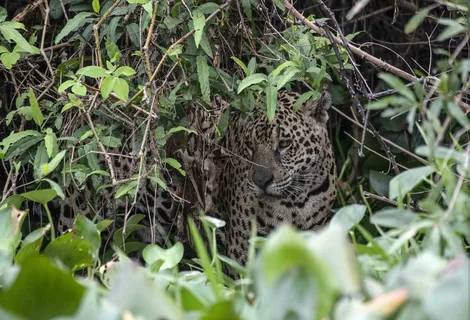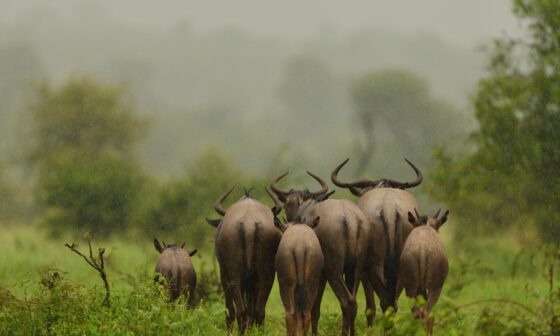Introduction
Picture this: you’re hiking through the vibrant, almost otherworldly depths of a tropical rainforest. The humidity clings to your skin, the hum of insects and distant birdcalls fill the air—and everything seems alive. But what you don’t see is far more chilling than what you do. Beneath the thick underbrush, hanging silently from trees, or gliding through shadowy rivers, camouflaged predators are watching… waiting. These jungle assassins strike without a whisper, their presence masked by evolutionary brilliance.
In nature’s grand theater, camouflage isn’t just a clever costume—it’s a deadly tool. Whether it’s for stalking prey or avoiding becoming someone else’s dinner, the ability to blend in seamlessly often marks the difference between life and death. Today, we’re venturing into some of the world’s most dangerous jungles to uncover how these unseen killers—both terrestrial and aquatic—ambush without a sound.
This post dives deep into the fascinating realm of stealth hunters, the science behind their invisibility, and the chilling beauty of their attacks. You’ll never look at a tree, a rock, or a ripple in the water the same way again.
The Deadly Art of Camouflage: A Jungle Overview
Before we spotlight specific predators, let’s talk about the core concept behind their success: camouflage. In the natural world, camouflage isn’t just about color—it’s about shape, texture, movement, and even scent. For jungle predators, it’s an essential evolutionary adaptation that allows them to get close enough to strike, often before the prey ever knows they’re there.
There are several types of camouflage tactics used by these jungle dwellers:
- Background matching: Blending into leaves, bark, mud, or forest floor.
- Disruptive coloration: Using bold patterns to break up the outline of the body.
- Mimicry: Imitating inanimate objects like vines or moss.
- Countershading: Lighter underside and darker topside to flatten appearance in natural light.
Let’s break down the jungle’s most notorious ambush artists and how they use these techniques to deadly effect.
Masters of Ambush: Camouflaged Predators on Land
1. Jaguar (Panthera onca)
Stealth Score: ★★★★★
Habitat: Amazon Rainforest (South America)
Don’t let the jaguar’s beautiful rosette-patterned fur fool you—this apex predator is nature’s ghost. Thanks to dappled sunlight streaming through the canopy, the jaguar’s coat perfectly mimics the broken light patterns of the jungle. Crouching low and moving silently through the underbrush, it often stalks its prey within 10 feet before launching an explosive, fatal attack—usually a skull-crushing bite.
Silent Tactic:
Jaguars rely on ambush rather than chase. Their short, powerful limbs and low-slung stance help them remain undetected, even when stepping just feet from their target.
2. Green Tree Python (Morelia viridis)
Stealth Score: ★★★★☆
Habitat: New Guinea, Northern Australia
Coiled like a lazy vine in the canopy, the green tree python is nearly invisible unless it moves. This ambush predator often stays motionless for hours—or even days—waiting for small mammals, birds, or reptiles to pass underneath.
Camouflage Trick:
Its vivid green body with yellow flecks makes it nearly indistinguishable from the surrounding foliage. Juveniles are often bright yellow or red, blending in with ground cover and leaves.
3. Malayan Horned Frog (Megophrys nasuta)
Stealth Score: ★★★★★
Habitat: Southeast Asian jungles
This little creature is a master of deception. With a body shaped like a dead leaf—right down to veined skin and pointed “horns” above its eyes—it’s a nearly perfect copy of jungle floor debris.
Lethal Surprise:
Insects land mere inches from it, unaware of the threat. The frog strikes lightning-fast with a sticky tongue, pulling prey in before they even realize what hit them.
4. Tiger (Panthera tigris) – India & Southeast Asia
Stealth Score: ★★★★☆
Habitat: Dense forests and grasslands
While not exactly jungle-exclusive, the tiger’s vertical stripes allow it to disappear among tall grasses and dense undergrowth. Even with its massive size, it can silently track prey for miles without being seen.
Camouflage Evolution:
The stripe pattern is unique to each tiger, much like human fingerprints, making them harder to spot even on infrared camera traps.
Lurkers Below: Aquatic Killers That Blend and Bite
1. Stonefish (Synanceia verrucosa)
Stealth Score: ★★★★★
Habitat: Coastal waters of Australia
This is where beauty turns truly lethal. The stonefish is the world’s most venomous fish, and it resembles—no exaggeration—a lump of coral-covered rock. It lies on ocean floors or among rocks, waiting for unsuspecting fish or divers to make a fatal misstep.
Lethal Weapon:
When disturbed, it deploys sharp dorsal spines that inject powerful venom, causing excruciating pain, paralysis, and sometimes death if not treated.
2. Freshwater Crocodile (Crocodylus johnstoni)
Stealth Score: ★★★★☆
Habitat: Northern Australia
While not as aggressive as its saltwater cousin, the freshwater croc is a patient hunter. Often submerged just below the surface, its body mirrors the reflection of the surrounding jungle canopy.
Ambush Style:
With eyes and nostrils barely above water, it remains almost completely invisible until it lunges with startling speed—typically in less than 0.5 seconds.
3. Electric Eel (Electrophorus electricus)
Stealth Score: ★★★★☆
Habitat: Amazon River Basin
Though not strictly a camouflage expert in terms of color, the electric eel uses murky waters to stay hidden. It detects and ambushes prey using electrolocation and stuns it with a jolt of electricity up to 600 volts.
Predator’s Edge:
This eel often hides under submerged logs or within muddy riverbeds—completely invisible until the zap.
Why Understanding Hidden Jungle Killers Matters in 2025
So why does any of this matter in a modern world filled with urban jungles and air-conditioned offices? Because whether you’re a hiker, diver, eco-tourist, or even just a nature enthusiast, knowing how these predators operate could literally save your life.
And beyond personal safety, studying these hidden predators helps with:
- Medical breakthroughs: Venoms from stonefish and snake species are being used in pain management and blood pressure medications.
- Biomimicry: Engineers are studying how camouflage works at a molecular level to develop new types of stealth materials.
- Conservation efforts: Understanding predator-prey dynamics helps protect endangered ecosystems.
As human activity expands into wild places, encounters between people and wildlife increase. Education becomes a key line of defense—both for human safety and for preserving delicate natural balances.
Table: Comparison of Jungle Predators by Region and Camouflage Strategy
| Predator | Region | Camouflage Strategy | Threat Level to Humans | Notable Feature |
|---|---|---|---|---|
| Jaguar | South America | Background matching | High | Skull-crushing bite |
| Green Tree Python | Australia | Mimicry (vines) | Low | Arboreal ambush hunting |
| Stonefish | Australia | Rock mimicry | Very High | World’s most venomous fish |
| Electric Eel | South America | Murky water concealment | Medium | Delivers 600-volt shock |
| Malayan Horned Frog | Southeast Asia | Leaf mimicry | None | Perfect jungle floor mimic |
| Freshwater Crocodile | Australia | Surface reflection | Medium | Submerged strike ambusher |
Key Insights: What These Killers Can Teach Us
Nature’s stealth assassins show us that camouflage is more than invisibility—it’s a multi-sensory strategy. They don’t just hide visually; they control sound, movement, and even chemical signals.
Key Takeaways:
- Stillness is power: Many predators rely on absolute stillness to avoid detection.
- The element of surprise is everything in both defense and offense.
- Blending in isn’t passive—it’s an active hunting technique.
- Diversity of tactics means no single strategy rules the jungle.
Understanding these principles is not only useful for wildlife studies or outdoor survival—but also offers metaphors and applications in technology, design, and even military strategy.
Real-World Examples: Camouflaged Killers in the USA and Australia
United States: The Eastern Copperhead
Found in wooded areas across the southeastern USA, the eastern copperhead snake is an expert in leaf-litter camouflage. Its hourglass patterns mimic dead leaves so precisely that hikers often step within inches before noticing.
In fact, the CDC warns that most venomous snake bites in the USA occur because the snake wasn’t seen at all—a direct result of its camouflage mastery.
(Source: CDC Snakebite Prevention Guide)
Australia: The Leaf-Tailed Gecko
This elusive lizard is nearly impossible to see when clinging to bark or tree trunks. Its flattened tail, bark-like skin texture, and nocturnal habits make it a wonder of natural design. It’s not a predator of humans, of course—but it demonstrates how widespread camouflage tactics are among Australian wildlife.
CSIRO research has found that Australia hosts the highest diversity of camouflaged reptile species globally, making it a hotspot for evolutionary adaptation.
(Source: CSIRO Australia)
Conclusion: Be Wary, Be Wise—and Look Twice
The jungle is not just a place of beauty—it’s a place of calculated silence and unseen motion. The most dangerous animals aren’t always the ones that roar or rattle; they’re the ones you never see coming. From snakes that look like leaves to fish that resemble rocks, these camouflaged predators define the ruthless elegance of nature’s deadliest game.
Understanding their tactics isn’t just for the biologists or adventurers among us—it’s for anyone who values awareness, respect for the wild, and a little evolutionary awe.
So next time you’re out in nature—or even just admiring a photo of a lush rainforest—ask yourself: What might be hiding in plain sight?
Call to Action:
If you’re planning travel to rainforest regions, diving trips, or hiking expeditions, arm yourself with knowledge—not fear. Respect the wild, learn about local fauna, and consider a certified guide when venturing into unfamiliar ecosystems.
Because in the jungle, what you don’t see can definitely hurt you.
Would you like this post formatted for Medium or WordPress? I can help generate that too.

